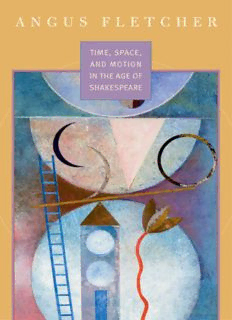
Time, Space, and Motion in the Age of Shakespeare PDF
Preview Time, Space, and Motion in the Age of Shakespeare
Time, Space, and Motion in the Age of Shakespeare Angus Fletcher Time, Space, and Motion in the Age of Shakespeare Harvard University Press Cambridge,Massachusetts,andLondon,England2007 Copyright©2007bythePresidentandFellowsofHarvardCollege Allrightsreserved PrintedintheUnitedStatesofAmerica LibraryofCongressCataloging-in-PublicationData Fletcher,Angus,1930– Time,space,andmotionintheAgeofShakespeare / AngusFletcher. p. cm. Includesbibliographicalreferencesandindex. ISBN-13:978-0-674-02308-6(alk.paper) ISBN-10:0-674-02308-0(alk.paper) 1.Englishpoetry—Earlymodern,1500–1700—Historyandcriticism. 2.Literatureand science—England—History—17thcentury. 3.Literatureandscience—England—History— 16thcentury. 4.Motioninliterature. 5.Renaissance—England. PR535.S33F552007 321′.30936—dc22 2006043576 Contents Introduction 1 1 Galileo’sMetaphor 12 2 TheThemeofMotion 21 3 OnDrama,Poetry,andMovement 36 4 MarloweInventstheDeadline 55 5 TheDefenseoftheInterim 70 6 StructureofanEpitaph 95 7 Donne’sApocryphalWit 113 8 MiltonandtheMoonsofJupiter 130 Conclusion 152 Notes 159 Acknowledgments 176 Index Time, Space, and Motion in the Age of Shakespeare Introduction Imaginativeliteratureisthesubjectofthisbook,yetourdiscussionmustbe- gin elsewhere, in the field of ideas and the history of religion. There the contextualinterestsofliteraturearelinkedtoonestartlingdevelopment:a broad-based radical change in fundamental attitudes, a shift generated by theriseofearlymodernscience.DuringthefrightfulconflictoftheSecond World War, Lucien Febvre looked back to a somewhat parallel period; he wrotethatthroughoutEuropetherehadbeen“aproblemofunbeliefinthe sixteenth century,” a picture few historians would care to contradict.1 Tur- bulent collisions of ideological conviction are not hard to discern, while skepticism and what some thought to be atheistic forays against the true faith created all the conditions for a storm of religious warfare—the storm broke savagely during the Thirty Years’ War—and at the very least for un- relenting religious ambivalence. If we begin, as did Lucien Febvre, with the omnipresent differences among various religious sects, we must guard against being entrapped inside their religious doubts. Given the complex characterofChristianity,givenexternalpressuresfromIslam,giventhein- herently obscure nature of religious mystery, there was assuredly no easy wayfor“unbelief”tofindadoctrinalpathtoharmony. Withinthislargecircleofideasweshallask,soonerorlater,whereskepti- cism could possibly find a successful alternative authority. In philosophy perhaps? Or in science, as it took its first serious steps toward Newtonian mechanics? Or in the occult, including Gnosticism, the kabala, and al- chemy?Onethingissurprisingaboutourownperiod:chroniclingtheWars ofTruth,historiansspeakofthateraasacrisisoffaith,yettheydonotsuf- ficientlyclarifyonecriticalperspectiveuponthisstrifeanduncertainty—the crisisofnaturalscienceandnaturalknowledge.Thereisclearlystillnocom- fortablewaytojuxtaposereligionandscience,excepttonotetheirfrequent 1
Description: